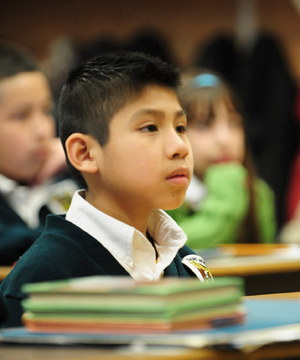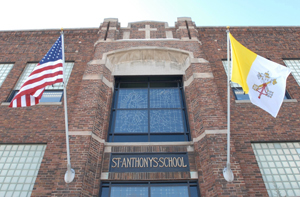
“Well, a number of the kids from St. Anthony School are registering to attend,” said Terry Brown, St. Anthony president, regarding the enrollment of the private parish school. “This news just took place on Friday, so we had some initial discussions with principals of neighboring Catholic schools and we’re working right now to prepare information for them, so the school is open to the community.
“We already have children registered from several local public schools and Lutheran schools and Catholic schools,” he added.
This is the first Catholic high school to open in the archdiocese since Thomas More was established in 1972 by the merger of Don Bosco and Pio Nono. Catholic high schools that once served the south side of Milwaukee include the all-girls Mercy High School, closed in 1973; co-ed Notre Dame, closed in 1988; and all-girls St. Mary’s Academy, closed in 1991.
St. Anthony plans to open its high school on its campus at 1727 S. 9th St. Prior to the 2010-2011 school year it will search for a location that can accommodate the anticipated number of students, a minimum property size of 30,000 to 40,000 square feet, according to the proposal.
The high school, which will continue to use the St. Anthony name, will initially have room for 80 freshmen, with a grade level added each year. In five years the school plans to have room for 400 students, according to Brown.
The idea to expand came as graduating St. Anthony Choice students could not attend surrounding area Catholic high schools, either because of limited capacity or transportation issues. Many had to attend charter or public high schools — a move that wasn’t preferred by many parents who rely on the Milwaukee Parental Choice Program for educational funding, according to the proposal.
Tuition for a non-Choice student at St. Anthony is $6,700, the value of a Choice voucher. While the school serves students who live, for the most part, on the near south side of Milwaukee and are of Hispanic origin, it is open to all children, according to Brown.
The high school is considered to be a great asset to the archdiocese, according to Archbishop Dolan, but not one without challenges. The proposed budget for St. Anthony High School is $750,000, and includes combination of Choice vouchers, grants and revenues but does not include archdiocesan funds. Brown said they hope to get more than $500,000 in financial support from various foundations, but declined to identify the foundations and the amounts they were planning to commit.
“Obviously, you know that opening any school this day is a towering challenge — a high school even more,” Archbishop Dolan explained. “You’ve got to have expert faculty, you’ve got to have your credentials in order, you’ve got to have a promising, sound curriculum, you’ve got to have space available.”
St. Anthony High School, he said, will have all that and more because of the school administration’s excellent ratio of “imagination and realism.”
Although Archbishop Dolan clarified that St. Anthony is not primarily a Latino school, he is excited for the students, who come from primarily Spanish-speaking homes who will benefit from a Catholic high school education. Helping serve everyone, he said, is the heart of Catholic education.
“We still have immigrants, and we have to meet their pastoral needs, and the great majority of immigrants and newly arrived, who are a gift to the Catholic Church in Southeastern Wisconsin,” Archbishop Dolan said. “(They) are Latino origin, and therefore, I just rejoice that even though this is not an exclusive Latino high school, it is indeed flying the flag of Catholic education right in the middle of one of our proud Latino neighborhoods.

“So, what the church is saying is, we’re still in this business. The church still has open arms to our newly arriving immigrants and their children and grandchildren, and we don’t want to let them down. The church was there when our grandparents and great-grandparents came, and darn it, the church is still here, and one of the most noble and effective ways we can serve them is through our wonderful Catholic schools,” he said.
Finding a more suitable building to house the projected number of students and finding teachers for all grades are among the immediate tasks for school officials.
“The principal is already working on creating a job description for both teachers who are already on staff, and new hires. So, we will probably be hiring over the next four years, adding 20 positions, and we want it to be a mix of current employees and new hires,” Brown said, adding that in an effort to maintain the culture that has been established in the grade school, many of the teachers currently on staff will move to teach the new grades. Principal Ramon Cruz will remain principal of both schools for the next two years, until new faculty can be found for the high school.
Brown also plans to expand the grade school curriculum for the future high school students, including four years of Humane Letters (history and literature, with civics and economics in their final year), catechism, Latin and Spanish, natural sciences and mathematics.
Dave Lodes, superintendent of archdiocesan schools, does not anticipate St. Anthony High School having a negative impact on existing Catholic high schools.
“In its original plan, there’s a certain number of students that go to Messmer and St. Joan Antida, but there are a certain number of students who are leaving St. Anthony who are going to charter schools,” he said. “Although this will be open to all students for enrollment, there is anticipation (St. Anthony) will be filling that niche of those students that normally would have gone to charter schools.”
Cynthia Marino, president of St. Joan Antida High School, disagreed.
“Well, I really don’t know what kind of impact it will have, but I really wasn’t happy about the decision, knowing that we have at least 50 seats available at St. Joan Antida,” she said about the all-girls school, which also participates in the Choice program.
“The majority of our girls are Hispanic and live on the south side, and we don’t provide transportation because we don’t have the resources to provide busing. I think, because it is so close and right in the community, (St. Anthony High School) could potentially be a problem for us.”
“It’s mixed emotions,” said Chuck Allison, director of archdiocesan schools. “Everyone is under a lot of enrollment pressure, and understandably there is always another player in town who will either hurt us or help us. But I think everyone understands the overall mission, which will be to fill a much-needed gap in serving the Hispanic community, as well as keeping people in the ‘Catholic family.’”
Divine Savior Holy Angels High School president Ellen Bartel said that good things will come from the new high school, if the administration is seeking to fill a gap.
“I think that the important thing for us is that St. Anthony said that they’re interested in serving children who are eligible for the Milwaukee Parental Choice program, that currently are not finding a space in the Catholic high schools,” she said. “With that expressed intent on their part, we’re supportive of them doing that. We have not drawn a large number of students on an annual basis from St. Anthony, so they’re seeking to serve a population that they are experiencing is underserved, and so if they can provide that service, that’s a good thing.”
“What excites me is that this is Catholic education at its best, because it’s grassroots,” Archbishop Dolan said.
“This is not some idea that trickled down from my office. This is a grassroots – parents, priests, teachers, lay leaders – who came together and said, ‘We want this to work. We need this and our kids need this, and we’re going to dig in and make it happen.’ The wisdom and genius of Catholic education has always been (that) we grow up in neighborhoods and local communities, and you can see that in action (at St. Anthony).”
